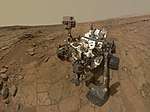Gliese 3470 b
Gliese 3470 b, abbreviated as GJ3470b, is an exoplanet orbiting the star Gliese 3470, both of which are located in the constellation Cancer. With a mass of just under 14 Earth-masses and a radius approximately 4.3 times that of Earth's, it is likely something akin to a mini-Neptune despite the initially strong belief that the planet was not covered in clouds like the gas giants we are familiar with in our solar system. The planet belong to the rare category of Super-puffs.
 Size comparison of Gliese 3470 b with Earth. | |
| Discovery | |
|---|---|
| Discovered by | X. Bonfils et. al [1] |
| Discovery date | 2012 |
| Radial velocity | |
| Orbital characteristics | |
| 0.031±0.0028 AU | |
| Eccentricity | 0.114±0.052[2] |
| 3.3366487+0.0000043 −0.0000033 d | |
| Inclination | 88.88+0.62 −0.45 |
| Star | Gliese 3470 |
| Physical characteristics | |
Mean radius | 4.19±0.58 R⊕ |
| Mass | 12.57±1.3[3] M⊕ |
Mean density | 1.18±0.33 g cm−3 |
| Temperature | 604±98 |
Atmosphere
The Gliese 3470 b being the one of the first discovered super-puffs, the planetary atmosphere is one of the best specroscopically characterized among all exoplanets.
The exoplanet's atmosphere was first observed by researchers Akihiko Fukui, Norio Narita and Kenji Kuroda at the University of Tokyo in 2013, and afterwards, Fukui commented, "Suppose the atmosphere consists of hydrogen and helium, the mass of the atmosphere would be 5–20% of the total mass of the planet. Comparing that to the fact that the mass of Earth's atmosphere is about one ten-thousandth of a percent (0.0001%) of the total mass of the Earth, this planet has a considerably thick atmosphere."[4] Recently in 2015, a team using the Las Cumbres Observatory Global Telescope (LCOGT) network reported their detection of Rayleigh scattering in the atmosphere of this planet. In the Las Cumbres researchers' paper published in The Astrophysical Journal, they conclude that the most plausible explanation for the scattering effect to be an atmosphere made predominantly of hydrogen and helium, causing the exoplanet to be veiled by dense clouds and hazes.[5] It is thought that the planet would appear blue to the human eye due to this scattering.
In 2017-2019, the primary hydrogen atmosphere with overall low metallicity, depleted methane and traces of water was characterized.[6][7] It is likely filling an entire Roche lobe of the planet.[8] In 2019 and 2020, a singly ionized helium outflow was detected in the atmosphere of Gliese 3470 b, indicating the atmosphere is currently escaping at rate 30,000-100,000 tons per second, or 0.16-0.53 Earth masses per billion years.[9][10]
Gallery
See also
References
- Bonfils, X; Gillon, M; Udry, S; Armstrong, D; Bouchy, F; Delfosse, X; Forveille, T; Jehin, E; Lendl, M; Lovis, C; Mayor, M; McCormac, J; Neves, V; Pepe, F; Perrier, C; Pollaco, D; Queloz, D; Santos, N. C; Santos, N. C (2012). "A hot Uranus transiting the nearby M dwarf GJ3470. Detected with HARPS velocimetry. Captured in transit with TRAPPIST photometry". Astronomy & Astrophysics. 546: A27. arXiv:1206.5307. Bibcode:2012A&A...546A..27B. doi:10.1051/0004-6361/201219623.
- exoplanet.eu Planet GJ 3470 b
- "GJ 3470 B".
- Fukui, Akihiko; et al. (2013). "Optical-to-Near-Infrared Simultaneous Observations for the Hot Uranus GJ3470b: A Hint for Cloud-free Atmosphere". The Astrophysical Journal. 770 (2): 95. arXiv:1302.7257. Bibcode:2013ApJ...770...95F. doi:10.1088/0004-637X/770/2/95.
- Dragomir, Diana; et al. (2015). "Rayleigh Scattering in the Atmosphere of the Warm Exo-Neptune GJ 3470b". The Astrophysical Journal. 814 (2): 9. arXiv:1511.05601. Bibcode:2015ApJ...814..102D. doi:10.1088/0004-637X/814/2/102.
- Chen, G.; Guenther, E. W.; Pallé, E.; Nortmann, L.; Nowak, G.; Kunz, S.; Parviainen, H.; Murgas, F. (2017). "The GTC exoplanet transit spectroscopy survey". Astronomy & Astrophysics. 600: A138. arXiv:1703.01817. doi:10.1051/0004-6361/201630228.
- Benneke, Björn; Knutson, Heather A.; Lothringer, Joshua; Crossfield, Ian J.M.; Moses, Julianne I.; Morley, Caroline; Kreidberg, Laura; Fulton, Benjamin J.; Dragomir, Diana; Howard, Andrew W.; Wong, Ian; Désert, Jean-Michel; McCullough, Peter R.; Kempton, Eliza M.-R.; Fortney, Jonathan; Gilliland, Ronald; Deming, Drake; Kammer, Joshua (2019). "A sub-Neptune exoplanet with a low-metallicity methane-depleted atmosphere and Mie-scattering clouds". Nature Astronomy. 3 (9): 813–821. arXiv:1907.00449. Bibcode:2019NatAs...3..813B. doi:10.1038/s41550-019-0800-5.
- Bourrier, V.; Lecavelier Des Etangs, A.; Ehrenreich, D.; Sanz-Forcada, J.; Allart, R.; Ballester, G. E.; Buchhave, L. A.; Cohen, O.; Deming, D.; Evans, T. M.; García Muñoz, A.; Henry, G. W.; Kataria, T.; Lavvas, P.; Lewis, N.; López-Morales, M.; Marley, M.; Sing, D. K.; Wakeford, H. R. (2018). "Hubble PanCET: An extended upper atmosphere of neutral hydrogen around the warm Neptune GJ 3470b". Astronomy & Astrophysics. 620: A147. arXiv:1812.05119. Bibcode:2018A&A...620A.147B. doi:10.1051/0004-6361/201833675.
- Palle, E.; Nortmann, L.; Casasayas-Barris, N.; Lampón, M.; López-Puertas, M.; Caballero, J. A.; Sanz-Forcada, J.; Lara, L. M.; Nagel, E.; Yan, F.; Alonso-Floriano, F. J.; Amado, P. J.; Chen, G.; Cifuentes, C.; Cortés-Contreras, M.; Czesla, S.; Molaverdikhani, K.; Montes, D.; Passegger, V. M.; Quirrenbach, A.; Reiners, A.; Ribas, I.; Sánchez-López, A.; Schweitzer, A.; Stangret, M.; Zapatero Osorio, M. R.; Zechmeister, M. (2020). "A He I upper atmosphere around the warm Neptune GJ 3470b". arXiv:2004.12812 [astro-ph.EP].
- Ninan, Joe P.; Stefansson, Gudmundur; Mahadevan, Suvrath; Bender, Chad; Robertson, Paul; Ramsey, Lawrence; Terrien, Ryan; Wright, Jason; Diddams, Scott A.; Kanodia, Shubham; Cochran, William; Endl, Michael; Ford, Eric B.; Fredrick, Connor; Halverson, Samuel; Hearty, Fred; Jennings, Jeff; Kaplan, Kyle; Lubar, Emily; Metcalf, Andrew J.; Monson, Andrew; Nitroy, Colin; Roy, Arpita; Schwab, Christian (2019). "Evidence for He I 10830 Å~ absorption during the transit of a warm Neptune around the M-dwarf GJ 3470 with the Habitable-zone Planet Finder". arXiv:1910.02070 [astro-ph.EP].
- "Structure of Exoplanet GJ 3470 b". www.spacetelescope.org. Retrieved 5 July 2019.
- "Artist's impression of gas streaming from GJ 3470b". www.spacetelescope.org. Retrieved 17 December 2018.




